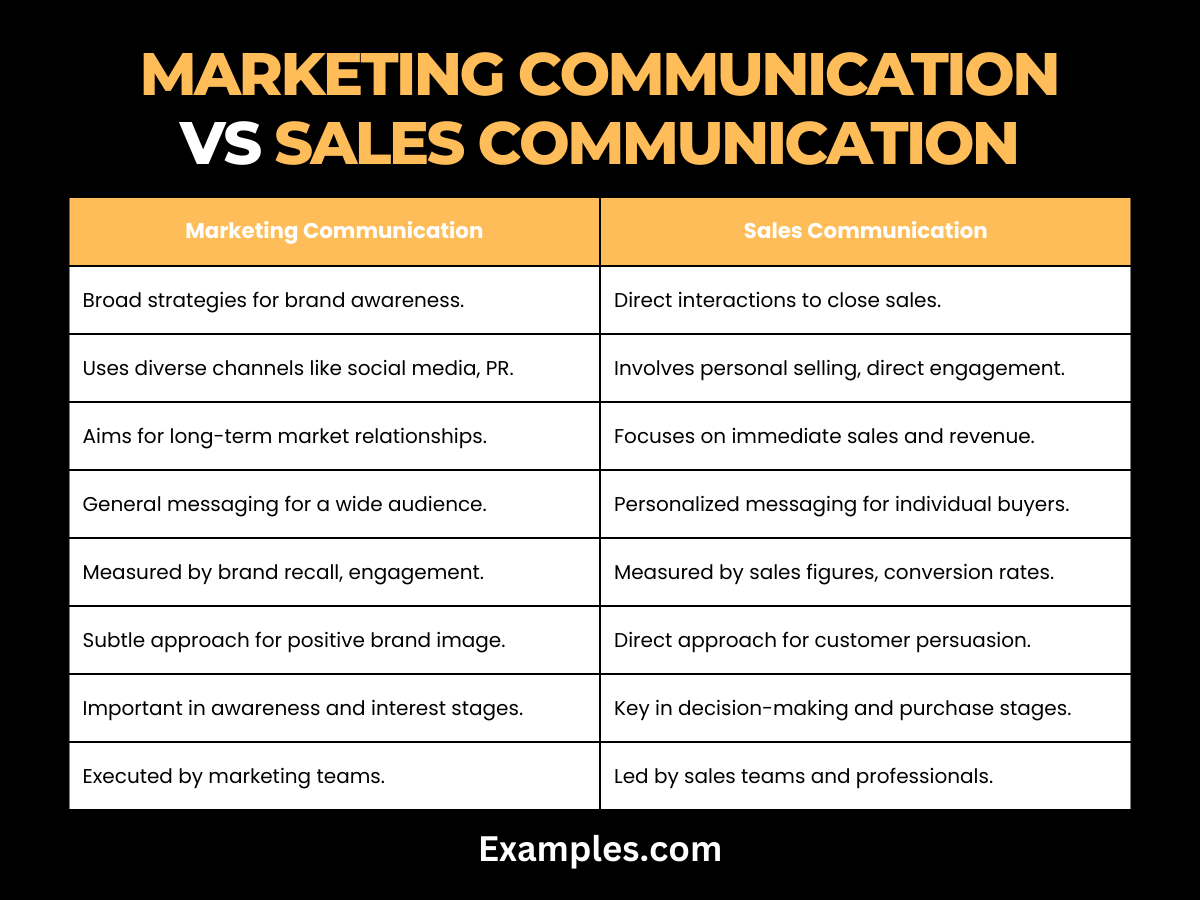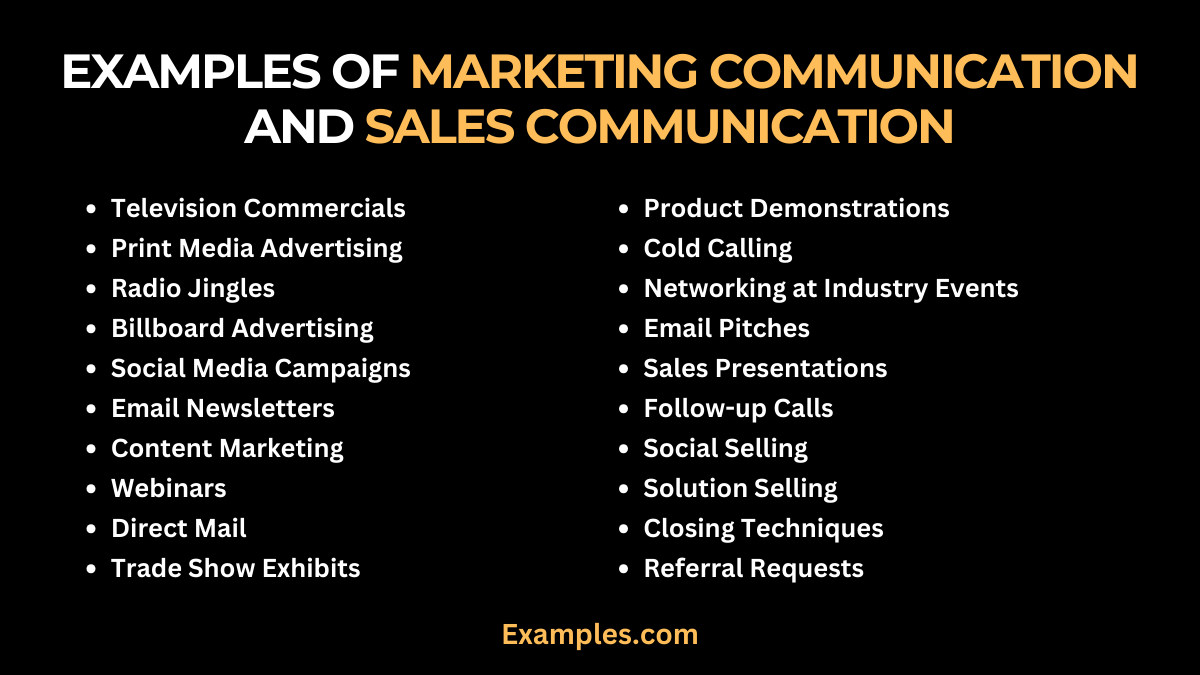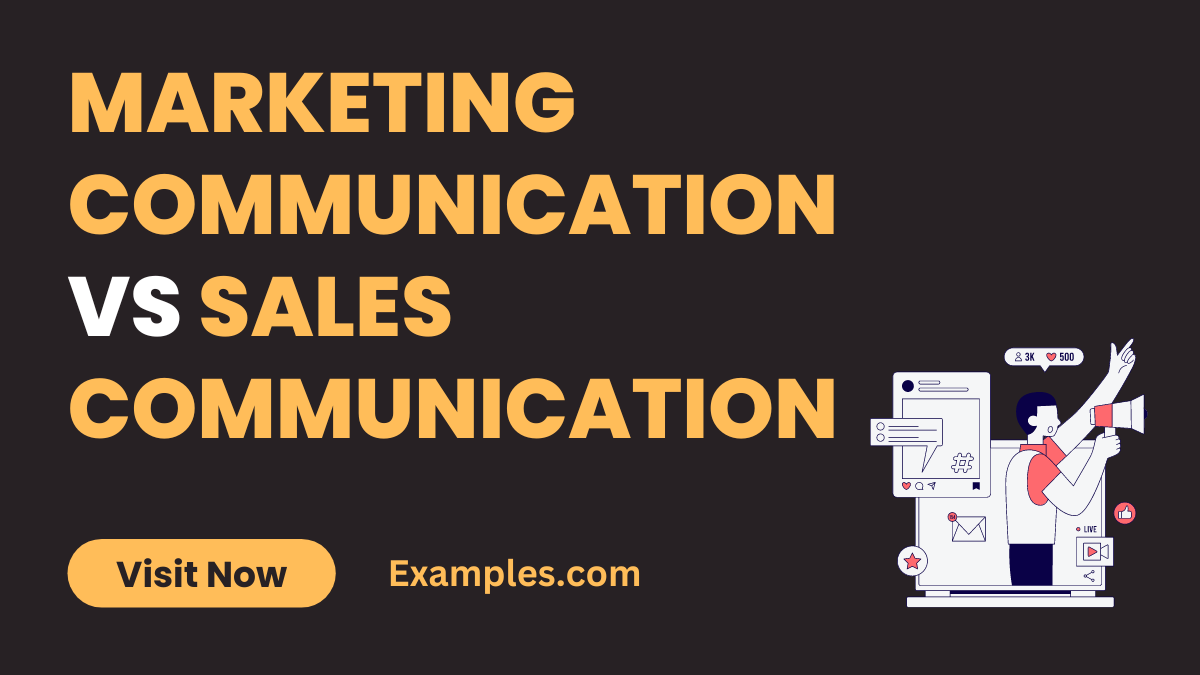Marketing Communication vs Sales Communication
Dive into the intricate world of “Marketing Communication vs Sales Communication” where strategic engagement meets persuasive dialogue. This comprehensive guide illuminates the subtle yet crucial differences between these two pivotal business functions. With a wealth of practical Communication Examples, you’ll discover how each approach shapes customer perception and drives business success. From nuanced strategies to impactful tips, unlock the secrets to mastering these essential communication forms and enhancing your marketing and sales effectiveness.
Download Marketing Communication PDF
Download Sales Communication PDF
Difference Between Marketing Communication vs Sales Communication
In the sphere of “Marketing Communication,” differentiating between Marketing Communication and Sales Communication is key to developing a holistic business approach. Below is a detailed table that outlines their primary differences, aiding in understanding how each contributes uniquely to business success.

| Marketing Communication | Sales Communication |
|---|---|
| Encompasses a broad spectrum of strategies aimed at building brand awareness and generating interest in products or services. | Focuses specifically on direct interactions with customers to close sales and generate revenue. |
| Utilizes various channels like social media, advertising, PR, and content marketing to reach a wider audience. | Involves personal selling techniques, direct customer engagement through calls, meetings, and presentations. |
| Aims to create a favorable brand image and establish a long-term relationship with the target market. | Targets the immediate conversion of prospects into customers, emphasizing short-term goals. |
| Messaging is often general, seeking to inform, persuade, and remind the audience about the brand or products. | Messaging is highly personalized, addressing specific needs and concerns of potential buyers. |
| The success is measured through metrics like brand recall, customer engagement, and the effectiveness of marketing campaigns. | Success is directly tied to sales figures, conversion rates, and meeting sales targets. |
| Tends to be more subtle and indirect in its approach, focusing on creating a positive brand perception. | More direct and aggressive, with a clear focus on persuading customers to make a purchase. |
| Plays a crucial role in the initial stages of the buying process, including awareness and interest. | Becomes more prominent in the latter stages of the buying process, particularly during decision-making and action. |
| Marketing communication strategies are developed and executed by marketing teams and professionals. | Sales communication strategies are often the responsibility of sales teams and customer relationship managers. |
| Utilizes creative and informative content to engage and educate the audience. | Employs persuasive techniques and negotiation skills to convince and convert leads. |
| Acts as a support system for sales communication, creating a favorable environment for sales activities. | Often relies on the groundwork laid by marketing communication to effectively engage with informed customers. |
10 Marketing Communication Examples
Marketing Communication is an integral component of business strategy, encompassing various tools and methods to convey a brand’s message. This guide provides ten distinct examples, each illustrating the depth and range of Integrated Marketing Communication Methods and Integrated Marketing Communication Strategies. From digital campaigns to traditional advertising, these examples demonstrate how effectively tailored communication can engage and influence the target audience.

- Television Commercials: Powerful visual storytelling on TV.
Example: A heartwarming TV commercial that narrates the journey of a family and their connection with your brand, reinforcing emotional appeal. - Print Media Advertising: Classic yet effective, using newspapers and magazines.
Example: A full-page ad in a leading magazine showcasing your product’s unique features alongside compelling visuals. - Radio Jingles: Catchy tunes on the radio that stick in the listener’s mind.
Example: A memorable jingle played during peak commute hours, highlighting your brand’s tagline. - Billboard Advertising: Large-scale visuals for high-impact awareness.
Example: An eye-catching billboard in a high-traffic area, displaying a bold message about your latest product. - Social Media Campaigns: Engaging online audiences through platforms like Facebook and Instagram.
Example: A social media challenge that encourages user participation and content sharing related to your brand. - Email Newsletters: Personalized communication to nurture leads.
Example: A monthly newsletter with industry insights, product updates, and exclusive offers tailored to subscriber interests. - Content Marketing: Providing valuable information through blogs or videos.
Example: An informative blog series addressing common customer questions, establishing your brand as a thought leader. - Webinars: Educating and engaging audiences online.
Example: Hosting an interactive webinar to demonstrate your product’s capabilities and answer live questions. - Direct Mail: Personalized letters or postcards for a targeted approach.
Example: Sending out well-designed postcards to local residents announcing a store opening with exclusive offers. - Trade Show Exhibits: Face-to-face interaction at industry events.
Example: An interactive booth at a trade show, showcasing product demos and offering expert consultations.
10 Sales Communication Examples
Sales Communication is a pivotal aspect of business, complementing the Components of Integrated Marketing Communications and enhancing its Functions. This guide provides ten clear examples of Sales Communication, showcasing diverse tactics used by sales professionals to connect, persuade, and close deals with customers. Each example demonstrates how sales communication is distinct yet harmonious with broader marketing strategies, playing a critical role in converting leads generated by marketing efforts into successful sales.
- Product Demonstrations: Showcasing product features in a detailed, hands-on manner.
Example: During a product demo, highlight the unique features of your product, explaining how it solves specific customer problems. - Cold Calling: Initiating contact with potential customers over the phone.
Example: Start the call with a brief introduction and a compelling reason for your call, focusing on the recipient’s potential needs. - Networking at Industry Events: Building relationships with potential clients in person.
Example: At a conference, engage attendees by discussing industry trends and subtly introducing your product’s relevance. - Email Pitches: Crafting persuasive and personalized sales emails.
Example: Send a tailored email that addresses the recipient’s business needs, outlining how your product can provide a solution. - Sales Presentations: Formal presentations aimed at decision-makers.
Example: Create a compelling PowerPoint presentation that highlights key product benefits, backed by data and customer testimonials. - Follow-up Calls: Keeping in touch with prospects after initial contact.
Example: Make a follow-up call to inquire about any decision-making progress and reiterate your offer’s value. - Social Selling: Using social media platforms for sales engagement.
Example: Leverage LinkedIn to connect with prospects, sharing relevant content and engaging in conversations about their business challenges. - Solution Selling: Focusing on customer problems and how your product can solve them.
Example: In discussions, emphasize how your product uniquely addresses the specific challenges faced by the customer. - Closing Techniques: Strategies used to seal the deal.
Example: Employ the “assumptive close” by discussing next steps as if the customer has already decided to purchase. - Referral Requests: Asking satisfied customers to refer new potential clients.
Example: After a successful sale, ask the customer if they know anyone else who could benefit from your product, offering incentives for referrals.
Comparison & Relationship Between Marketing Communication vs Sales Communication
In the context of “Marketing Communication,” it’s vital to understand how it contrasts with and complements Sales Communication. Both are crucial components of a business’s strategy, particularly when integrated within sectors like Integrated Marketing Communication in Tourism and Integrated Marketing Communication in Advertising.
The Distinctive Roles
Marketing Communication is about crafting and disseminating messages to inform, persuade, and remind the audience about a brand, its products, or services. It’s a broad field encompassing advertising, PR, digital marketing, and more. The aim here is to create a strong brand image and nurture a long-term relationship with the target audience.
On the other hand, Sales Communication is more direct and immediate. It involves one-on-one interactions with customers, focusing on converting leads into sales. Sales Communication is about understanding customer needs, addressing objections, and closing deals.
Key Differences in Approach
- Scope and Objective: Marketing Communication is broader in scope, aiming to reach a wide audience to build brand awareness and generate leads. Sales Communication targets individual prospects or customers with the goal of making a sale.
- Content and Style: The content of Marketing Communication is generally informative and persuasive, while Sales Communication is more personalized, addressing specific customer concerns and needs.
- Channels Used: Marketing Communication uses a variety of channels, from traditional media to digital platforms. In contrast, Sales Communication often happens through personal interactions, phone calls, emails, or face-to-face meetings.
- Duration and Impact: The impact of Marketing Communication is measured over a longer period, focusing on brand loyalty and customer lifetime value. Sales Communication has a more immediate impact, seen in sales figures and conversion rates.
Synergistic Relationship
The relationship between Marketing Communication and Sales Communication is synergistic and interdependent:
- Lead Generation and Conversion: Marketing Communication plays a vital role in generating and nurturing leads, which Sales Communication then works to convert into sales.
- Feedback Loop: Insights from Sales Communication can inform and refine Marketing Communication strategies, making them more effective.
- Brand Consistency: It’s essential for both Marketing and Sales Communication to maintain consistent brand messaging for a coherent customer experience, especially evident in sectors like tourism and advertising.
Integrated Marketing Communication Strategies
Incorporating both Marketing and Sales Communication into an Integrated Marketing Communication strategy ensures that all customer touchpoints convey a unified message. This integration is particularly effective in industries like tourism and advertising, where cohesive brand experiences directly impact customer decisions.
- Collaborative Efforts: Regular collaboration between marketing and sales teams ensures alignment in strategies and goals.
- Unified Messaging: Consistent messaging across marketing and sales helps in building a strong, trustworthy brand image.
- Customer Journey Focus: Understanding the customer journey from awareness to purchase allows for more targeted and effective communication strategies in both marketing and sales.
In conclusion, this complete guide on Marketing Communication vs Sales Communication provides a comprehensive understanding of their distinct roles and synergies. By integrating these key strategies within the Components of Integrated Marketing Communications and utilizing their unique Functions, businesses can create a cohesive approach to customer engagement. Pursuing Integrated Marketing Communication in Public Relations further empowers professionals to master these essential skills, enhancing business success in today’s dynamic market.



